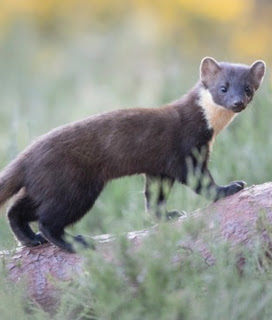Overwintering honey bees is a worry. One can’t help but think that hives are just not thick enough to provide good thermal insulation. They must be though as most hives survive the winter. Next year I think I’ll put sheep’s wool under the roofs. Fingers crossed for the spring.
Sunday, 11 December 2022
Honey Bees Overwintering
Wednesday, 7 December 2022
Pine Martens Released
Pine Martens have been reintroduced into the Forest of Dean in an effort to control the grey squirrel. Apparently it has worked amazingly well in Ireland. The grey squirrels are not only consumed by the martens but also so scared by them they won’t feed or reproduce. The martens struggle to predate on the red due to the squirrel’s ability to move onto small, thin branches and the fact they spend very little time on the ground, unlike the grey. Eighteen martens have been reintroduced so hopefully they’ll spread throughout the region. They became extinct in the 19th Century due to gamekeeper persecution: let’s hope there’s no trouble this time.
https://www.discoverwildlife.com/news/pine-martens-released-into-the-forest-of-dean/
https://www.discoverwildlife.com/news/pine-martens-released-into-the-forest-of-dean/
www.arlingtonpestcontrol.co.uk
Sunday, 4 December 2022
I read the other day that the Norway rat came over to the British Isles at the same time as the House of Hanover was established. It was mooted that the rats were aboard the ship that brought George I to these shores in 1714. Being German and inheriting a hugely complex political and religious situation George became universally unpopular.....as did the Norway rat of course. The tenuous connection between the House of Hanover the the new rats was forged and wags of the time gave the rats the name 'Hanoverians'.
Thursday, 1 December 2022
Mustelids are a family of carnivorous mammals which include the weasel, stoat, badger, otter, pole cat, mink, wolverine and domesticated ferret. With their long, muscular bodies and short legs they are highly efficient and fearless killers as anyone who has seen a diminutive stoat tackle a full grown rabbit will testify.
We don't see the badger and the otter as big weasels, but that's what they are. Culturally we are inordinately fond of both badger and otter, but not many people give a thought to the stoat and weasel. And those that do tend not to like them. Another example of our weirdly contradictory attitude towards wild animals. In the past we used to spend a lot more time thinking about the weasel as they were an important animal in medieval iconography. In the medieval bestiary the weasel signified someone who had heard the divine word and yet did nothing about it. Many carvings of long, thin weasels adorn our churches, such as at St John's Cirencester.
http://laurieplant.com/2012/03/drawing-the-new-gargoyles-for-cirencester-parish-church/
And the difference between a stoat and a weasel? The stoat is a little longer (20-30cm) than the weasel and has a longer tail (7-12cm) with black tip. I can't remember the hilarious joke....stoatally different? Don't forget too that it was the winter coat of the stoat which provided ermine for the gowns of the peerage. Let's hope they use faux stoat now though.
www.arlingtonpestcontrol.co.uk
We don't see the badger and the otter as big weasels, but that's what they are. Culturally we are inordinately fond of both badger and otter, but not many people give a thought to the stoat and weasel. And those that do tend not to like them. Another example of our weirdly contradictory attitude towards wild animals. In the past we used to spend a lot more time thinking about the weasel as they were an important animal in medieval iconography. In the medieval bestiary the weasel signified someone who had heard the divine word and yet did nothing about it. Many carvings of long, thin weasels adorn our churches, such as at St John's Cirencester.
http://laurieplant.com/2012/03/drawing-the-new-gargoyles-for-cirencester-parish-church/
And the difference between a stoat and a weasel? The stoat is a little longer (20-30cm) than the weasel and has a longer tail (7-12cm) with black tip. I can't remember the hilarious joke....stoatally different? Don't forget too that it was the winter coat of the stoat which provided ermine for the gowns of the peerage. Let's hope they use faux stoat now though.
www.arlingtonpestcontrol.co.uk
Subscribe to:
Posts (Atom)



